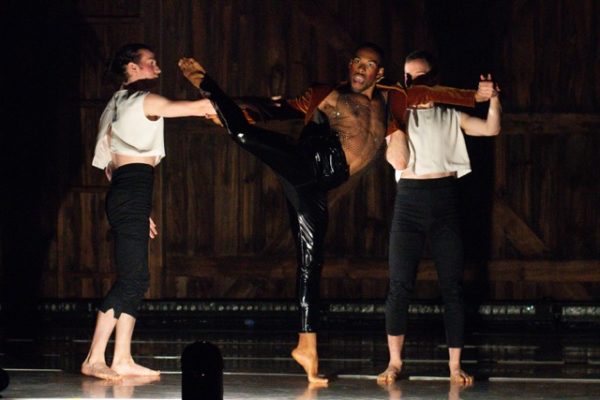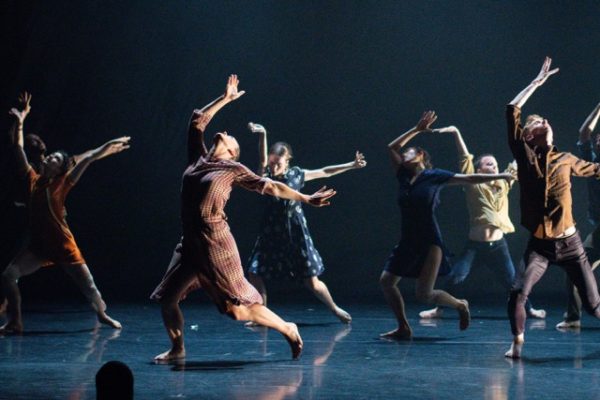Dance Review: “Gallim” — Extremes of Stress and Release
By Jessica Lockhart
Gallim specializes in depicting raw emotions through movement.
Gallim, at Jacob’s Pillow, Beckett, MA, through August 11.

Gallim in action. Photo: Grace Kathryn Landefeld.
After a recent matinee at Jacob’s Pillow featuring the contemporary company Gallim, the dancers were seen lying outside on the grass of the campus’s wooded hill. They laughed, took pictures, and ran over to pat and hug a nearby dog. It was great to see them as regular people — not the intense performers who had just ravaged the Ted Shawn Theater 90 minutes before. But that’s the beauty of being in the countryside at this festival. As we watch accomplished artistic performances, nature can be acknowledged and enjoyed as well.
Andrea Miller is the founder and choreographer of Gallim. Her company specializes in depicting raw emotions through movement. Her dancers are precise … about human imprecision: they get at the sloppiness people betray through their physicality — the spell cast by despair, fear, or love. Their movements are not pretty; they present how life’s ugliness affects the body. They illustrate dejection via shoulders hunched forward, disbelief with crooked necks. But, as they leapt across the stage, they could also beamed with joy, holding out their arms out-stretched. Miller’s dancers are asked to embody a wide emotional spectrum — extremes of stress and release.
The first piece presented dated from 2016. Boat was created in response to the Syrian refugee crisis. It began with the stage backdrop moving fluidly, images that swelled like waves. The music was Berliner Messe, a religious composition by Estonian composer Arvo Pärt. The dancers moved with big sweeping gestures that conveyed traveling and searching. They were in quest of something as they reached out to one another for support. This desperate journey took many forms, moving from the quiet to the frenetic. Miller’s use of dramatic and bold lighting, as well as the piece’s passionate music, added to the overall sense of enormous struggle — these were people who are working hard to survive in a very difficult situation.
Two men ran in a big circle around the stage. One had his hands over the other man’s eyes. He can’t see. Then they switch, the next man is now blind. How do you find your way to a new home when you can’t see the path? Another simple but poignant gesture: three women stand, then slowly bend forward, their heads hanging down, their hands braced on their knees. They held completely still; there was no movement for quite some time. The action, to me, was an evocation of absolute despair. The search for freedom continued, with the bodies of the dancers moving quickly, their pairings generating enormous dynamic force. The piece ends with a dancer lying still on the ground — abandoned and presumed dead. There is no help. How can we let this happen?

Another glimpse of Gallim in action. Photo: Grace Kathryn Landefeld.
The second piece was a world premiere. True, very, and it featured highlights compiled from Miller’s past decade of work. Her program note was very cryptic: “A poetry of the real. Verismo dethroned romanticism. Really, really. The dusk of archetypal heroes. The dawn of stories…..” The description was confusing, as is the work itself, perhaps because putting together samples from various dances refuse to accumulate into any coherent sense. Taking the form of eight vignettes, True, very had Miller’s excellent dancers moving from contorted poses to silly stances. The performers’s cheeks were painted red: a consciousness-raising image that has become a symbol (for some) of domestic violence against women. This notion of liberation might connect Miller’s notes with one of the intentions behind the dance. But it is a thin thread in which to tie together disparate samples of the choreographer’s work.
In the piece, we see two women lying on the floor in distorted (though gymnastic) upside-down poses. One woman says, “I have been chosen to tell you the truth, I have accepted. I have to wear a mask, I hate masks,” and she screams. Then a man — dressed in glitter and leather pants — lip-syncs as two other men manipulate him as if he were a puppet. Women appear in dresses covered in sequins. Juxtaposing scenes of flashy glam with people in turmoil might be Miller’s way of dramatizing the struggle some people face when they are being abused. Was she exploring how outward appearances disguise inner anguish? And how opposing feelings of strength and weakness control us?
Miller included a small sample from her most recent piece, To Create a World, which was inspired by her time as an artist-in-residence in New York City’s Metropolitan Museum of Art. This talented young choreographer been described by critics as “ground-breaking.” She seems to be making good on these hopes.
Jessica Lockhart is a National Endowment for the Arts Fellow in Dance Criticism and has a BA in Communication from the University of Southern Maine. Lockhart is a Maine Association of Broadcasters award winning independent journalist. Currently, she also works as program director at WMPG Community radio.
